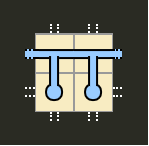A continuation in the Pipes puzzle series.
Problem statement for math nerds: Let $G(N)$ denote the graph consisting of cardinally adjacently linked lattice points on an $N \times N$ toroidal grid. For which $N$ does there exist a spanning tree of $G(N)$ in which every vertex has degree $1$ or $3$?
On the same website I linked to in the last problem, there is a curious variant of Pipes that removes the borders of the game, and instead allows pipes to wrap around in their solution (but as always, they must remain loop-free):
One reason I like Pipes played on a torus besides the added difficulty is that it is more essentially minimalist; there is no "edge" and "center," instead we have a topologically homogeneous space.
What if we endeavored to make a version that's even more minimalist, and even more difficult? There are four types of tile that may comprise a Pipes puzzle: The bulbs with only one neighbor, the corners and straights with two neighbors, and the T's with three neighbors. We obviously need to keep the bulbs in any version of the game, and among all the tiles I would say in my experience playing Pipes that T's are the most ornery, so let's also keep them. The only problem is: Are there even any (square grid) Pipes puzzles to play when you use only bulbs and T's?
(Extra credit: What is the situation—with and without border wrapping—on arbitrary $m \times n$ grids?)








